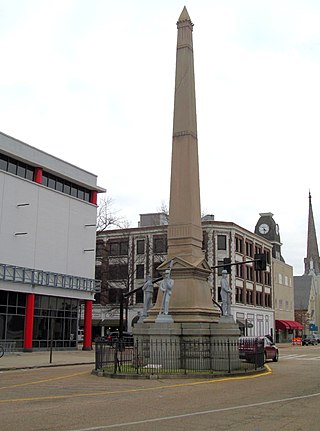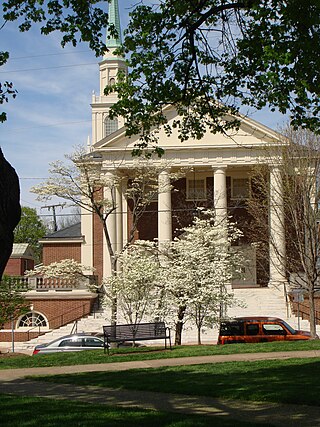
The Confederate War Memorial was a 65 foot (20 m)-high monument that pays tribute to soldiers and sailors from Texas who served with the Confederate States of America (CSA) during the American Civil War. The monument was dedicated in 1897, following the laying of its cornerstone the previous year. Originally located in Sullivan Park near downtown Dallas, Texas, United States, the monument was relocated in 1961 to the nearby Pioneer Park Cemetery in the Convention Center District, next to the Dallas Convention Center and Pioneer Plaza.

Michael Signer is an American attorney, author, and politician who served as mayor of Charlottesville, Virginia.
Confederate monuments and memorials in the United States include public displays and symbols of the Confederate States of America (CSA), Confederate leaders, or Confederate soldiers of the American Civil War. Many monuments and memorials have been or will be removed under great controversy. Part of the commemoration of the American Civil War, these symbols include monuments and statues, flags, holidays and other observances, and the names of schools, roads, parks, bridges, buildings, counties, cities, lakes, dams, military bases, and other public structures. In a December 2018 special report, Smithsonian Magazine stated, "over the past ten years, taxpayers have directed at least $40 million to Confederate monuments—statues, homes, parks, museums, libraries, and cemeteries—and to Confederate heritage organizations."

The Confederate Monument in Portsmouth, Virginia, was built between 1876 and 1881. It was listed on the National Register of Historic Places (NRHP) in 1997.

Thomas Jonathan Jackson is a historic bronze equestrian statue of Confederate general Stonewall Jackson which was formerly located at Courthouse Historic District of Charlottesville, Virginia and installed in 1921. The statue was sculpted by Charles Keck and was the third of four works commissioned from members of the National Sculpture Society by philanthropist Paul Goodloe McIntire. It was the second of three statues McIntire donated to the city of Charlottesville, which he did over a period of five years from 1919 to 1924. The statue was listed on the National Register of Historic Places in 1997.

The Robert E. Lee Monument was an outdoor bronze equestrian statue of Confederate general Robert E. Lee and his horse Traveller located in Charlottesville, Virginia's Market Street Park in the Charlottesville and Albemarle County Courthouse Historic District. The statue was commissioned in 1917 and dedicated in 1924, and in 1997 was listed on the National Register of Historic Places. It was removed on July 10, 2021, and melted down in 2023.

The Unite the Right rally was a white supremacist rally that took place in Charlottesville, Virginia, from August 11–12, 2017. Marchers included members of the alt-right, neo-Confederates, neo-fascists, white nationalists, neo-Nazis, Klansmen, and far-right militias. Some groups chanted racist and antisemitic slogans and carried weapons, Nazi and neo-Nazi symbols, the Valknut, Confederate battle flags, Deus vult crosses, flags, and other symbols of various past and present antisemitic and anti-Islamic groups. The organizers' stated goals included the unification of the American white nationalist movement and opposing the proposed removal of the statue of General Robert E. Lee from Charlottesville's former Lee Park. The rally sparked a national debate over Confederate iconography, racial violence, and white supremacy.

Market Street Park, known as Lee Park until 2017, and as Emancipation Park from June 2017 to July 2018, is a public park in Charlottesville, Virginia.

Jason Eric Kessler is an American neo-Nazi, white supremacist, and antisemitic conspiracy theorist. Kessler organized the Unite the Right rally held in Charlottesville, Virginia, on August 11–12, 2017, and the Unite the Right 2 rally held on August 12, 2018.

More than 160 monuments and memorials to the Confederate States of America and associated figures have been removed from public spaces in the United States, all but five since 2015. Some have been removed by state and local governments; others have been torn down by protestors.
Payne v. City of Charlottesville is a 2017 lawsuit opposing the removal of Confederate monuments and memorials in Charlottesville, Virginia.
The Blue Ribbon Commission on Race, Memorials and Public Spaces is a committee in Charlottesville, Virginia which the city established in 2016 to address the Charlottesville historic monument controversy.
The Charlottesville historic monument controversy is the public discussion on how Charlottesville should respond to protesters who complain that various local monuments are racist. The controversy began before 2016 when protest groups in the community asked the city council for the local removal of Confederate monuments and memorials. Other monuments became part of the controversy, including those of Thomas Jefferson because of his ownership of slaves and those of Lewis and Clark for their advocacy of white colonists over Native Americans.
In a unanimous vote on July 1, 2019, the City Council of Charlottesville, Virginia, established a new city holiday, Liberation and Freedom Day, to be celebrated on March 3. Union Army troops, under the command of Major General Philip Sheridan, arrived in Charlottesville on March 3, 1865, liberating over 14,000 enslaved workers. "Blacks were the majority race in the Charlottesville-Albemarle area." In the 1870 Census, the first one in which Charlottesville appears, its population was 2,838.

At Ready (1909) is a memorial of a Confederate soldier originally located in front of the Albemarle County Courthouse in downtown Charlottesville, Virginia. The statue, popularly known as "Johnny Reb," and accompanying objects were removed on September 12, 2020. The statue and nearby cannon, and cannonballs were removed to be placed on display at the Third Winchester Battlefield, part of the Shenandoah Valley Battlefields National Historic District.










